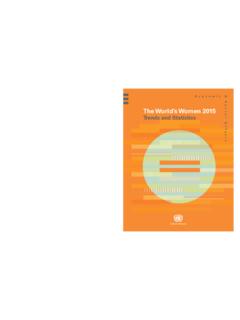Transcription of Reform of the national curriculum in England - GOV.UK
1 Reform of the national curriculum in England Equalities impact assessment July 2013 2 Contents Introduction 3 Policy context 4 The evidence base 5 Content of the programmes of study 5 Possible equalities impacts of the approach to the design of the new national curriculum programmes of study 12 Possible equalities impacts of the national curriculum aims 13 Possible equalities impacts of the national curriculum inclusion statement 13 Possible equalities impacts of the removal of levels and level descriptions 14 Possible equalities impacts of introducing foreign languages at key stage 2 15 Conclusion 17 3 Introduction This paper sets out an assessment of the potential impact on equalities created by the review of the national curriculum in England .
2 It considers whether and how the proposed changes to the national curriculum may impact positively or negatively on protected characteristics groups. Within a school context, the most relevant protected characteristics (as defined in the equality Act 2010) are pupil disability; race (including colour, nationality, ethnic or national origin); religion or belief (including lack of religion/belief); sex; and sexual Although the national curriculum is not specifically covered by the 2010 equality Act, the government is required to give due regard to the need to eliminate discrimination, advance equality of opportunity and foster good relations when carrying out its activities. In addition, one of the objectives of the review has been to ensure that opportunities are more equal for every child, including pupils with special educational needs (SEN).
3 For this reason, this assessment considers the possible impact of the new curriculum on pupils with SEN as well as disabled pupils. We have sought views through a public Call for Evidence at the start of the review; informal consultation and discussions that took place during the course of the review with stakeholders (including with representatives of equalities organisations, subject associations, teaching unions, headteachers, teachers and subject experts); and statutory consultation on the proposals for the new national curriculum between February and April 2013. The scope of this assessment covers, therefore, the potential impacts of: the changes to the content and design of the programmes of study the national curriculum aims the changes to the national curriculum inclusion statement the removal of attainment target levels and level descriptions the introduction of foreign languages at key stage 2.
4 1 The other protected characteristics defined in the equality Act 2010 relate to age; being or becoming a transsexual person; being married or in a civil partnership; and being pregnant or having a child. These are of less significance in the context of 5 -16 year olds in education , and were not addressed in the responses to the statutory consultation on the national curriculum . 4 Policy context In January 2011, the government launched a review of the national curriculum with the following aims: to ensure that the new national curriculum embodies rigour and high standards and creates coherence in what is taught in schools to ensure that all pupils are taught the essential knowledge in the key subject disciplines beyond that core, to allow teachers greater freedom to use their professionalism and expertise to help all pupils realise their potential.
5 The review has been informed by evidence on curricula in high-performing educational jurisdictions internationally. Surveys of pupils performance show that a number of jurisdictions consistently out-perform England , even in subjects where we perform relatively well. This is despite the best efforts of our many excellent Research has shown clear deficiencies in the current national curriculum in All high-performing systems strongly emphasise the fundamentals of core subjects and allocate them substantial time yet in England we have been moving away from this approach. Our analysis of the curricula in high-performing jurisdictions has shown, in particular, that our primary curriculum in mathematics and science does not set the same high standards and, in the 2007 revision of the secondary national curriculum , does not focus sufficiently on essential subject knowledge.
6 2 TIMSS 2011 results in science show that our performance in mathematics has not improved since 2007 at age 10, our mean score having remained almost unchanged at 542 (541 in 2007), or at age 14, where our mean score is 507 (513 in 2007). TIMSS science results show a drop in performance. At age 10, our mean score dropped significantly from 542 in 2007 to 529 in 2011, and at age 14 from 542 to 533. PISA 2009 results also show that we are behind high-performing jurisdictions in reading, with an above-average spread in attainment between those pupils who do well and those who do not. 3 Tim Oates (2010) Could do better: Using international comparisons to refine the national curriculum in England .
7 5 The evidence base The responses to the public consultation that covered the possible impact of the new national curriculum on pupils with protected characteristics most frequently referred to disability, ethnicity and belief/religion, with sex and sexuality being flagged in a handful of cases (and no mention being made of age, gender reassignment, pregnancy and maternity or being married). The following summary of evidence draws on responses to the public consultation on the new national curriculum , and also refers to views expressed by stakeholders in the initial Call for Evidence and through informal consultation. Where necessary, other evidence is referred to where some of the responses are contestable. Content of the programmes of study The statutory consultation asked respondents what impact positive or negative the proposals would have on pupils from groups with protected characteristics.
8 With over 1,500 responses to this specific question, a wide range of views were expressed. Some respondents stated that it was too early to determine whether there would be a negative or positive impact on protected characteristic groups. Many respondents highlighted that this issue was a matter of implementation, flagging the good work already being done in schools to ensure that all pupils succeed. Around a quarter of respondents felt that the proposals could impact negatively on protected groups (though without specifying which ones in particular). Respondents also raised the importance of curriculum flexibility to ensure that teachers had the space to tailor the curriculum to suit the individual needs of pupils. Some respondents felt that some of the content proposed was not accessible to pupils with special educational needs (SEN) and some disabled pupils, such as the programming in computing programmes of study and spoken language in the English programmes of study.
9 These particular issues are addressed in the subject content section below. The focus on essential knowledge in each subject The revised programmes of study set out the matters, skills and processes to be taught by the end of each key stage, with a change in emphasis towards essential knowledge in each subject area. The programmes of study are also significantly shorter all subjects except for English, mathematics and science in key stages 1 and 2. In slimming the national curriculum this way, it is intended that the programmes of study are sufficiently flexible to give teachers the freedom to specify more detail in their school curriculum for each subject and to determine the best ways in which to teach. Although some respondents to the consultation contested the importance of focusing the national curriculum on essential knowledge, there were very few responses that 6 suggested that there would be any disadvantage to particular protected groups.
10 Others have been supportive of this change, and agree with one of the key objectives of the review which is to ensure that all pupils irrespective of their background or circumstances have the opportunity to acquire the essential knowledge and skills they need to succeed in life. It is our belief that the new national curriculum programmes of study democratise knowledge by ensuring that as many children as possible can access a rich intellectual and cultural inheritance. Organisations representing pupils with special educational needs and disabilities (SEND) commented in particular that some deaf pupils will have less well-developed auditory memories so will find it challenging to absorb large amounts of information and subject vocabulary.














